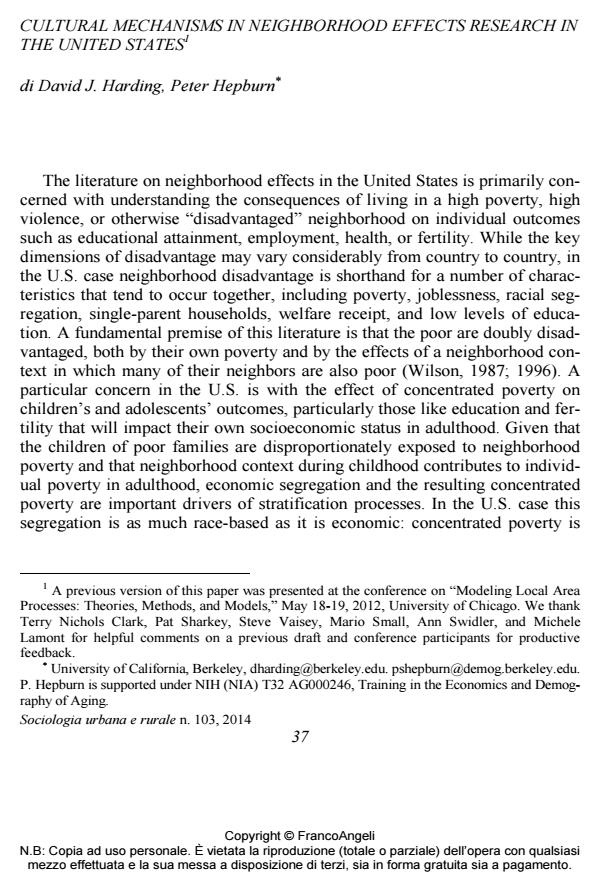Cultural mechanisms in neighborhood effects research in the united states
Titolo Rivista SOCIOLOGIA URBANA E RURALE
Autori/Curatori David J. Harding, Peter Hepburn
Anno di pubblicazione 2014 Fascicolo 2014/103
Lingua Inglese Numero pagine 37 P. 37-73 Dimensione file 787 KB
DOI 10.3280/SUR2014-103004
Il DOI è il codice a barre della proprietà intellettuale: per saperne di più
clicca qui
Qui sotto puoi vedere in anteprima la prima pagina di questo articolo.
Se questo articolo ti interessa, lo puoi acquistare (e scaricare in formato pdf) seguendo le facili indicazioni per acquistare il download credit. Acquista Download Credits per scaricare questo Articolo in formato PDF

FrancoAngeli è membro della Publishers International Linking Association, Inc (PILA)associazione indipendente e non profit per facilitare (attraverso i servizi tecnologici implementati da CrossRef.org) l’accesso degli studiosi ai contenuti digitali nelle pubblicazioni professionali e scientifiche
Il contributo discute lo stato attuale della letteratura statunitense sui meccanismi culturali nella ricerca sui neighborhood effects. In primo luogo si definisce cosa si intende per effetto quartiere e per meccanismi culturali. Si passa poi in rassegna e si fornisce un’analisi critica di due prospettive teoriche sul contesto culturale dei quartieri svantaggiati che sono esplicitamente integrate nella recente letteratura sui neighborhood effects negli Stati Uniti: la prospettiva della "subcultura deviante" e quella della "eterogeneità culturale". Gli autori hanno poi attinto dalla letteratura americana sugli studi urbani, dalla sociologia culturale su cultura e diseguaglianza per proporre alcune concettualizzazioni che possono rivelarsi utili nell’accrescere la comprensione del ruolo della cultura nei neighborhood effects. Infine si discutono le questioni concettuali e metodologiche che dovranno essere affrontate per un avanzamento delle riflessioni sul tema e si conclude offrendo proposte concrete, sia a breve che a lungo termine, per un’agenda di ricerca.
Parole chiave:Povertà, quartiere, cultura, meccanismo, repertorio, eterogeneità.
- What the Study of Legal Cynicism and Crime Can Tell Us About Reliability, Validity, and Versatility in Law and Social Science Research John Hagan, Bill McCarthy, Daniel Herda, in Annual Review of Law and Social Science /2020 pp.1
DOI: 10.1146/annurev-lawsocsci-031620-093358 - Neighborhoods, Schools, and Adolescent Violence: Ecological Relative Deprivation, Disadvantage Saturation, or Cumulative Disadvantage? Nicolo P. Pinchak, Raymond R. Swisher, in Journal of Youth and Adolescence /2022 pp.261
DOI: 10.1007/s10964-021-01551-8 - “The Belief to Aspire”: The Association Between Afrocentric Values in the Educational and Career Aspirations of Young Black Males Husain Lateef, Adrian Gale, Francine Jellesma, Ellie Borgstrom, in The Urban Review /2024 pp.19
DOI: 10.1007/s11256-023-00680-7 - Youth and Their Ideal Neighborhoods: How Do Ideals Compare to Lived Realities Across Different Neighborhoods in Nashville, Tennessee? Kayla M. Anderson, Kathryn Y. Morgan, Megan L. McCormick, Kayla J. Fike, Brian D. Christens, in Youth /2025 pp.20
DOI: 10.3390/youth5010020 - Horizontal Immobility Eva Rosen, in American Sociological Review /2017 pp.270
DOI: 10.1177/0003122417695841 - Academic culture beyond the individual: Group-level norms and college enrollment John P. Bumpus, Angel L. Harris, Scott M. Lynch, in Social Science Research 102944/2024 pp.102944
DOI: 10.1016/j.ssresearch.2023.102944 - Neighborhood climates of legal cynicism and complaints about abuse of police power† Bill McCarthy, John Hagan, Daniel Herda, in Criminology /2020 pp.510
DOI: 10.1111/1745-9125.12246 - Do Municipal Contexts Matter for Adolescent Mental Health? A Within-Municipality Analysis of Nationwide Norwegian Survey Data Across Six Years Baeksan Yu, Tilmann von Soest, Ragnhild Bang Nes, in Research on Child and Adolescent Psychopathology /2024 pp.169
DOI: 10.1007/s10802-023-01123-3 - Meanings and attitudes regarding education and household spending priorities of the new middle-class families in Brazil Murilo Carrazedo Costa Filho, Angela Cavalcanti Rocha, in Journal of Consumer Culture /2022 pp.183
DOI: 10.1177/1469540520926246 - Dual-process theory of racial isolation, legal cynicism, and reported crime John Hagan, Bill McCarthy, Daniel Herda, Andrea Cann Chandrasekher, in Proceedings of the National Academy of Sciences /2018 pp.7190
DOI: 10.1073/pnas.1722210115 - Handbook of Classical Sociological Theory Terry Nichols Clark, Cary Wu, pp.421 (ISBN:978-3-030-78204-7)
- Minority Youth and Social Integration Dirk Enzmann, Ilka Kammigan, pp.81 (ISBN:978-3-319-89461-4)
- Is a ‘culture of plus-size women’ the independent effect of neighborhood disadvantage on female BMI? A cross-sectional study in two Chilean Municipalities Jossiana Robinovich, Hans Bosma, Bart van der Borne, Ximena Ossa, Sergio Muñoz, Anja Krumeich, in Social Science & Medicine 114019/2021 pp.114019
DOI: 10.1016/j.socscimed.2021.114019 - Neighborhood effect. Riflessioni a partire dall'esperimento Moving to Opportunity Marco Castrignanò, Carolina Mudan Marelli, in SOCIOLOGIA URBANA E RURALE 132/2023 pp.7
DOI: 10.3280/SUR2023-132001
David J. Harding, Peter Hepburn, Cultural mechanisms in neighborhood effects research in the united states in "SOCIOLOGIA URBANA E RURALE" 103/2014, pp 37-73, DOI: 10.3280/SUR2014-103004